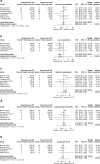An Overview of Clinical Outcomes in Transvenous and Subcutaneous ICD Patients
- PMID: 29992422
- PMCID: PMC6061190
- DOI: 10.1007/s11886-018-1021-8
An Overview of Clinical Outcomes in Transvenous and Subcutaneous ICD Patients
Abstract
Purpose of review: Clear guidelines on when to select a subcutaneous ICD (S-ICD) over a transvenous ICD (TV-ICD) are lacking. This review will provide an overview of the most recent clinical data on S-ICD and TV-ICD therapy by pooling comparison studies in order to aid clinical decision making.
Recent findings: Pooling of observational-matched studies demonstrated an incidence rate ratio (IRR) for device-related complication of 0.90 (95% CI 0.58-1.42) and IRR for lead-related complications of 0.15 (95% CI 0.06-0.39) in favor of S-ICD. The IRR for device infections was 2.00 (95% CI 0.95-4.22) in favor of TV-ICD. Both appropriate shocks (IRR 0.67 (95% CI 0.42-1.06)) and inappropriate shocks (IRR 1.17 (95% CI 0.77-1.79)) did not differ significantly between both groups. With randomized data underway, the observational data demonstrate that the S-ICD is associated with reduced lead complications, but this has not yet resulted in a significant reduction in total number of complications compared to TV-ICDs. New technologies are expected to make the S-ICD a more attractive alternative.
Keywords: Appropriate shocks; Complications; Inappropriate shocks; Infections; Subcutaneous implantable cardioverter defibrillator; Transvenous implantable cardioverter defibrillator.
Conflict of interest statement
Conflict of Interest
S.W.E. Baalman and A.B.E. Quast declare that they have no conflict of interest.
T.F. Brouwer reports grants from Boston Scientific.
R.E. Knops reports grants from Boston Scientific, Abbott, and Medtronic.
Human and Animal Rights and Informed Consent
This article does not contain any studies with human or animal subjects performed by any of the authors.
Figures

References
-
- Tracy CM, Epstein AE, Darbar D, DiMarco JP, Dunbar SB, Estes NA, III, et al. 2012 ACCF/AHA/HRS focused update of the 2008 guidelines for device-based therapy of cardiac rhythm abnormalities: a report of the American College of Cardiology Foundation/American Heart Association Task Force on Practice Guidelines and the Heart Rhythm Society. Circulation. 2012;126(14):1784–1800. doi: 10.1161/CIR.0b013e3182618569. - DOI - PubMed
-
- Mirowski M, Reid PR, Mower MM, Watkins L, Gott VL, Schauble JF, et al. Termination of malignant ventricular arrhythmias with an implanted automatic defibrillator in human beings. N Engl J Med. 1980;303(6):322–4. - PubMed
-
- Bardy GH, Smith WM, Hood MA, Crozier IG, Melton IC, Jordaens L, et al. An entirely subcutaneous implantable cardioverter–defibrillator. N Engl J Med. 2010;363(1):36–44. - PubMed
-
- Quast ABE, van Dijk VF, Yap SC, Maass AH, Boersma LVA, Theuns DA, et al. Six-year follow-up of the initial Dutch subcutaneous implantable cardioverter-defibrillator cohort: Long-term complications, replacements, and battery longevity. Journal of cardiovascular electrophysiology. 2018. - PubMed
Publication types
MeSH terms
LinkOut - more resources
Full Text Sources
Other Literature Sources
Medical
Research Materials

